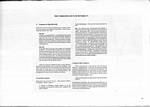|
|
 |
 |
AUSCHWITZ:
Technique
and Operation
of
the Gas Chambers © |
|
|
| |
 |
Back |
 |
Contents |
Page 181 |
 |
Home
Page |
Forward |
 |
| |
| THE UNDRESSING HUTS OF
BUNKER 2/V |
| |
V/ Testimony of Filip MÜLLER
Extracts
from “Trois ans dans une chambre à gaz
d’Auschwitz” [Three years in an Auschwitz gas chamber] by
Filip Müller, editions Pygmalion/Gerard Watelet, Paris 1980. |
| |
Page 169:
“In
Bunker 2, now renamed Bunker V an old whitewashed farm separated from the camp
by a little wood there was also great activity. Nobody could imagine that in
this country house, peaceful and ordinary, thousands of people would be
exterminated by gas. Kommandos of prisoners of all trades, electricians, metal
workers, road builders, succeeded in less than a year (this must be an error: a
month would be more accurate] in getting this installation of death
operational.“
Page 180:
“A few days later he
had three more cremation pits dug behind Krematorium V. He thus had five pits
at his disposal there now. Furthermore, the old farm situated to the west of
Krematorien IV and V, which had already been used as an extermination site in
1942, was brought back into service under the designation Bunker V and four
cremation pits were dug near the four rooms serving as gas chambers The
undressing rooms in which the victims left their clothes before being gassed
were transferred to three wooden huts There were no longer any numbered clothes
hooks or other camouflage in the form of signs or any other attempt to mislead
…” |
| |
I offer this account by F. Müller for what it is
worth. Much too late, thirty six years after the event, it is at the limit of
credibility. Fillip Müller is an important witness, but in choosing to
describe material and precise facts in a book and in 1979 (1st German edition)
he has accumulated errors, thus making his account historically dubious, The
best approach is to read it as a novel based on true history.
SS man
Böck's testimony
Extract from "Der Auschwitz
Prozess" [The Auschwitz Trial] by H. Langbein. Volume 1, page
74: |
| |
A comrade of Hölblinger, another member of
the SS, accompanied him one day in the vehicle to the ... [Bunker]. [His name
was Böck].
Deputy Judge Hummerich: “Were you present
at a gassing operation one day?”
Bock: “Yes, it was
one evening. I accompanied the driver Höblinger. A transport had arrived
from Holland and the prisoners had to jump from the wagons. They were well-off
Jews. Them were women with Persian furs. They arrived by express train. [They
disembarked at the "Jewish ramp" at Auschwitz station, not directly at
Birkenau. This account concerns 1942]. The trucks were already there, with
wooden steps before them, and the people climbed aboard. Then they all started
off In the place where Birkenau once stood, there was only a long
farmhouse (Bunker 2), and beside it four or five big huts. Inside, the
people were standing on clothes which were building up on the floor. The
‘Blockführer / block leader’, and the
‘Unterscharführer / sergeant’ carrying a cane were there.
Höblinger said to me: ‘Let's go over there now’, There was a
sign: ‘to disinfection’. He sad ‘You see, they're bringing
children now’, They opened the door, threw the children in and closed the
door. There was a terrible cry. A member of the SS climbed on the roof.
The people went on crying for about ten minutes. Then the prisoners opened the
doors. Everything was in disorder and contorted. Heat was given off The bodies
were loaded on a rough wagon and taken to a ditch. The next batch were already
undressing in the huts. After that I didn’t look at my wife for four
weeks.” |
| |
Comments of Böck's testimony:
There is
only one clue to show that the scene took place at Bunker 2: “a long
farmhouse”. In this type of account, this is already a good deal. SS Bock
seems to have been a decent enough man. The gassing of children upset him so
much that he saw the SS medical orderlies “climb on the roof” (they
did not climb so high) and did not look at his wife for four weeks. Not
everyone is cut out to be an executioner: Hermann Langbein writes: |
| |
"Böck is the only SS witness who
demonstrated a sincere aversion before the court." |
| |
| I would just ask one question: “How many gassings did
Böck see?” If he saw only the one he described before the court, it
is not so surprising that his “aversion” should remain intact. If he
had been forced by his duties to see them regularly, his attitude might have
been different. It is all too easy to become hardened |
|
| |
AUSCHWITZ:
Technique and operation
of the gas
chambers
Jean-Claude Pressac
© 1989, The Beate Klarsfeld Foundation |
 |
Back |
Page 181 |
Forward |
 |
|

